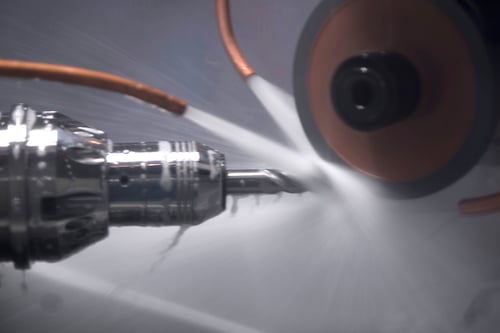The Importance of Knowing Your Surface Feet Per Minute (SFPM)
If you use diamond or CBN wheels, you are probably aware that the wheels have a specific range that they are designed to optimally work in. The wheels also have a maximum safe operating speed. Ignoring that speed can be dangerous to the operator and damage machinery.

How do you know what those speeds are and how they are calculated?
SFPM (Surface feet per minute): Knowing your wheel rim speed in SFPM (surface feet per minute) is a vital part of your grinding operation. Failure to use the wheels within the specified range will at best yield poor results such as burning the tool, loading or glazing the wheel bond, and poor wheel life. Worst case it can cause catastrophic failure and potential personal injury.
SFPM is calculated using the formula below and the wheel should always be used somewhere within the recommended range.
SFPM=0.262 x Diameter x Spindle RPM
All superabrasive bond systems are designed to operate within a certain SFPM range. You can adjust the performance of a wheel simply by varying the SFPM rate towards the higher range to achieve better wheel life, a better surface finish, and often a lower spindle load. Conversely, you can make the wheel remove material faster, reduce the chances of burning the tool or the wheel, and potentially decrease cycle times by adjusting the wheel SFPM towards the lower range of the recommendations.
The following table indicates a rough idea of the minimum and maximum SFPM for each wheel bond. Note that this is just a guideline, before operating your wheel, speak to your application engineer and they will give you tighter guidelines for the use of the wheel based upon various factors such as machine type and operation, material being ground, coolant being used, etc.
| Wet grind | SFPM | Dry grind | SFPM |
| Resin Bond | 3937-9843 | Resin Bond | 3937-7874 |
| Poly Bond | 3937-9843 | Poly Bond | 3937-7874 |
| Metal bond | 3937-15748 | Metal bond | 3937-9843 |
| Vit bond (OD grinding) | Dia(4921-6890) CBN(8858-31496) |
Vit bond
|
N/M |
| Vit bond (ID grinding) | 4921-13780 | N/M | |
| EP Bond | Dia(3940-6895) CBN(5910-9850) | EP Bond | Dia(3940-6895) CBN(5910-9850) |
| Hybrid bond | 3150-5906 | Hybrid bond | 3150-4921 |
| Vacuum brazed | Dia(3940-6895) CBN(5910-9850) | Vacuum brazed | Dia(3940-6895) CBN(5910-9850) |
| Rubber bond | <5906 | Rubber bond | <5906 |
What is V/Max (Maximum Velocity): All of Eagle Superabrasives wheels are tested and marked with a maximum wheel speed marking. This is shown on the wheel as V/Max or maximum Velocity and is shown in Meters per Second for example V/Max 63M/S.
Three main factors determine the maximum SFPM or V/Max speed a wheel can be safely operated. First is wheel core material. Typically, a wheel made of a steel core will have a higher SFPM rating than a wheel made with a composite core such as Bakelite or a pressed Aluminum powdered core. The steel core is much more difficult to damage and has a much lower risk of disintegrating than a Bakelite or other composite-type core. Second, careful consideration must be given to the abrasive bond type. Again, a metal-based bond will have a much greater integrity factor than a resin-based bond. The third factor is if the bond is a continuous rim or a segmented rim. Continuous rims have greater integrity than glued-on segmented rims.
Once you have the ideal SFPM for your grinding application, as provided by the application engineer, you need to calculate how to convert your machine's spindle RPM to achieve the ideal SFPM. Use the chart provided in the download and make sure your wheel is optimized.
![]()
If you feel you are not grinding optimally or have questions regarding the ideal wheel SFPM, Machine RPM, or anything else to do with your grinding operation, our engineers are standing by to assist in any way we can.
Recent Posts
Subscribe to email updates
Subscribe to our blog to get the latest updates from the experts on Grinding Wheels! You can easily unsubscribe at any time




